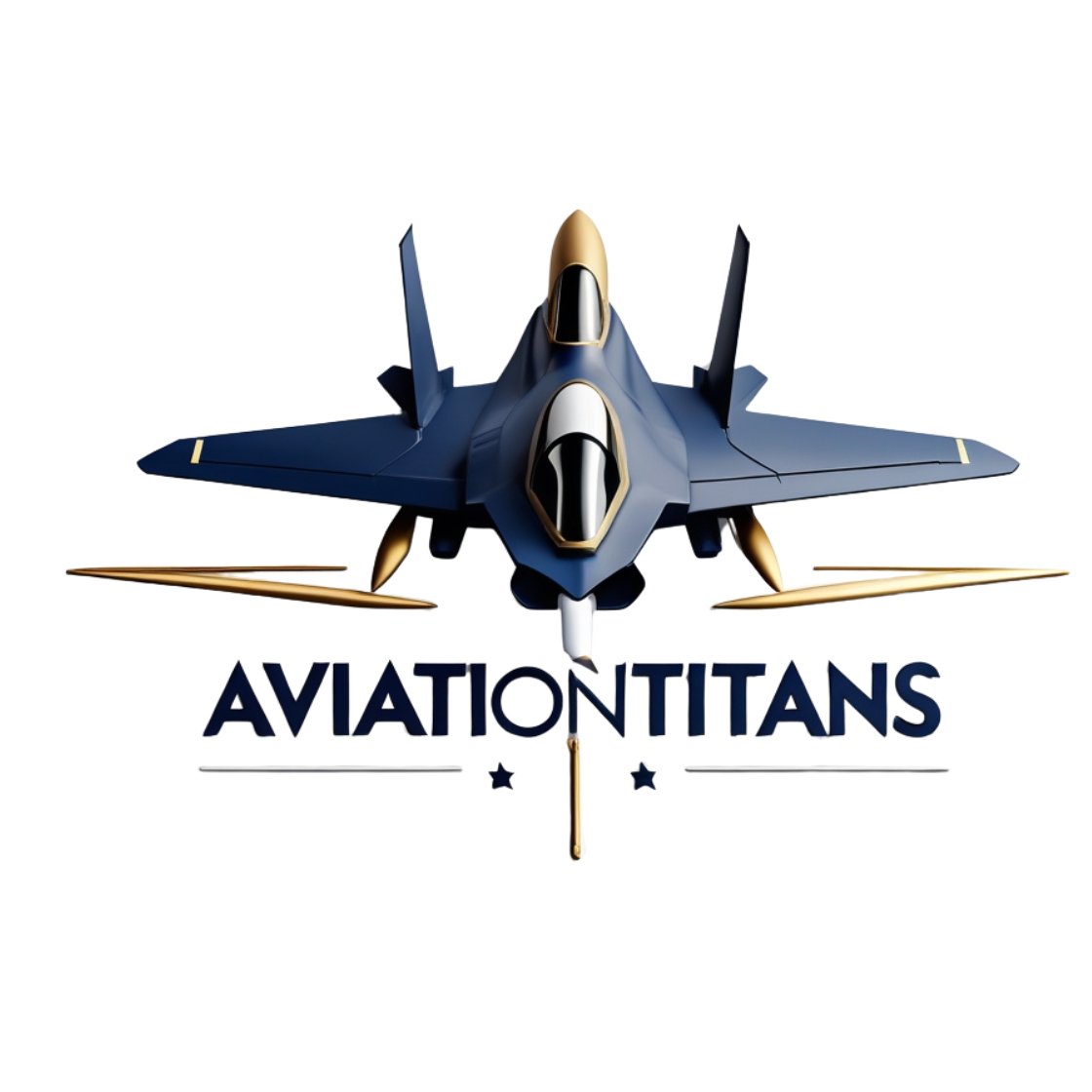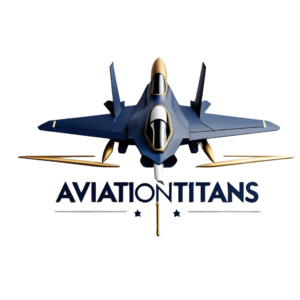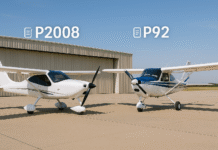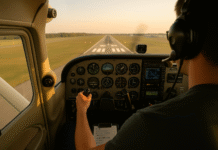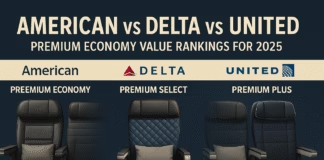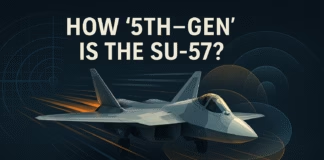TL;DR
- Part 141 = FAA-approved curriculum with stage checks and lower minimum hours (e.g., 35 hr PPL; 190 hr Commercial) but more structure. Part 61 = flexible path with higher minimums (e.g., 40 hr PPL; 250 hr Commercial) but similar typical totals for most students. eCFR+3Legal Information Institute+3eCFR+3
- Expect PPL total cost anywhere from ~$6k–$20k+ (and higher at some academies). Ask for all-in quotes with the same assumptions. AOPA+1
- Before you solo you’ll need a student pilot certificate and at least a third-class medical (gliders/balloons excepted). Non-U.S. citizens need TSA AFSP approval. TSA+3FAA+3eCFR+3
Part 61 vs. Part 141: what actually changes
Structure & oversight
- Part 141 schools operate to an FAA-approved syllabus with required stage checks and documented training records. That structure is audited and must be followed for each approved course. FAA+1
- Part 61 training can be done at any school or with an independent CFI; it’s flexible and can be tailored to your schedule and pace (no FAA-mandated stage checks). AOPA
Minimum hours (airplane ratings)
- Private Pilot (PPL): Part 61 = 40 hr minimum; Part 141 = 35 hr course minimum. (Most students exceed either minimum.) eCFR+1
- Instrument Rating: Part 61 requires 50 hr cross-country PIC plus 40 hr instrument time; Part 141 instrument course is 35 hr instrument training (the 50-hr PIC cross-country requirement does not apply under the 141 course). eCFR+1
- Commercial Pilot (CPL): Part 61 = 250 hr total time; Part 141 graduates may qualify at ~190 hr when completing the integrated 141 private+instrument+commercial sequence. eCFR+1
Reality check: Lower minimums don’t guarantee lower totals. Weather, schedule gaps, proficiency, and aircraft/CFI availability push many students beyond the minimum regardless of part.
Sim/FTD credit (a cost lever)
- PPL (61.109): Up to 2.5 hr (or 5 hr via Part 142) may count in a simulator/FTD. eCFR
- Instrument (61.65): Significant credit is allowed (e.g., up to 20–30 hr depending on device and training center). Smart schools use sims to cut cost and sharpen scan. eCFR
Career angle: R-ATP path
If your goal is the airlines, know that specific university programs can qualify you for a Restricted ATP at 1,000 or 1,250 hours (instead of 1,500), depending on degree/credits under §61.160. That consideration can trump the 61 vs. 141 choice by itself. eCFR
What a good syllabus looks like (and how to spot one)
Whether you train 61 or 141, ask to see the detailed training course outline. Look for:
- Clear lesson flow with objectives, completion standards, and pre-/post-briefs (not just “fly maneuvers”).
- Stage checks or mock checkrides at logical gates (even under 61). 141 requires them; 61 schools that embrace them typically post better first-time pass rates. Legal Information Institute
- Simulator integration for IFR and emergencies (and for PPL hood time), aligned with what hours will count per the regs. eCFR+1
- Currency cadence: the plan assumes 2–4 lessons per week (skill decay is expensive).
- Dispatch data: a published aircraft availability target (e.g., ≥85–90% dispatch) and how maintenance delays are handled.
- CFI continuity: how often you’ll switch instructors, and what happens when a CFI leaves for the airlines.
- Ground school options: live, online, or hybrid—with knowledge test scheduling built in.
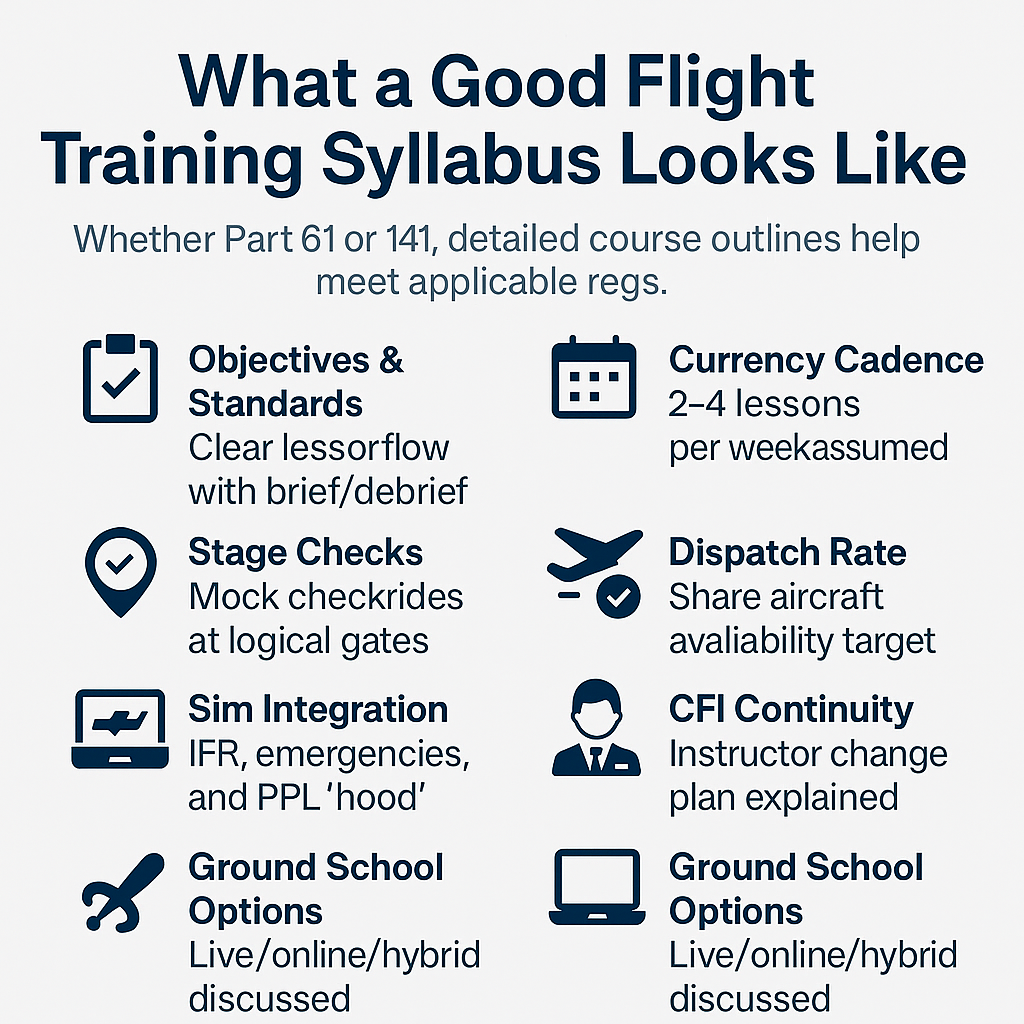
Red flags
- “Unlimited” packages with fuzzy fine print, no stage checks, or no instrument sim plan.
- No written policy on cancellations, billing, or weather.
- Can’t produce training records templates or show how your progress is tracked (a 141 must; great 61 schools do too). Legal Information Institute+1
Budgeting in 2025: what flight training really costs
PPL ballpark: credible national guidance still quotes ~$6,000–$20,000+ depending on location, pace, and aircraft. Some large academies quote higher bundled figures—always compare apples to apples. AOPA+1
Why it varies so much
- Airplane rate: 1970s trainer vs. G1000-equipped 172 with ADS-B and WAAS.
- CFI rate: ranges widely by region.
- Frequency: gaps add “re-learning” hours.
- Checkride access: examiner fees and wait times.
- Sim use: lowers IFR cost when integrated properly. eCFR
Pro tip: demand an “all-in” estimate for each certificate/rating that itemizes: aircraft wet rate, instructor, ground school, books/EFB, knowledge test & DPE fees, medical, headset, renters’ insurance, and expected sim credits. Then ask for a +15–25% overrun line—if you never need it, great.
Scholarships/aid
AOPA administers multiple scholarship programs each year—put them on your list. Schools may also partner with lenders; read APR and deferment terms carefully. AOPA
Must-dos before you start
- Student pilot certificate: Apply through IACRA (or paper 8710-1) via a CFI, DPE, or FSDO. FAA
- Medical certificate: For powered-aircraft solo you’ll need at least a third-class medical (first/second if you’re career-bound soon). Get it early to avoid surprises. eCFR+1
- TSA/AFSP (non-U.S. citizens): Security Threat Assessment approval must be in place before training that requires it—your school should guide you. TSA
Decision guide: which path fits you?
Choose Part 141 if you want:
- A tight, audited syllabus with stage checks and steady cadence.
- Eligibility for reduced minimums (Instrument & Commercial) under that course.
- A pipeline toward a university R-ATP program (common pairing). Legal Information Institute+2FAA+2
Choose Part 61 if you want:
- Maximum scheduling flexibility (shift work, seasons, kids).
- To train with a specific CFI or at a club where the culture clicks.
- Freedom to mix-and-match ground school providers and pace.
Either way, your actual time and cost depend more on frequency, quality of instruction, and aircraft availability than the regulation part number.
Interview the school: 14 questions that separate the pros from the rest
- What are your first-time pass rates (PPL/IFR/CPL) over the last 12 months?
- Show me the syllabus and where the stage checks sit. (61 schools: how do you stage-gate?) Legal Information Institute
- What’s your dispatch reliability and typical maintenance downtime?
- How many active CFIs? Average student-to-CFI ratio?
- How do you handle CFI turnover? Will I be reassigned quickly?
- How do you integrate sims/FTDs—and how many hours will count? eCFR+1
- Typical time to solo and time to checkride for students who fly 2–3× per week?
- Can I see a sample training record/progress report? (141 must keep and share on request.) Legal Information Institute
- What’s the aircraft mix (ages/avionics) and maintenance in-house vs. vendor?
- How soon can I get a DPE slot once I’m signed off?
- Do you rent to newly-certificated pilots (insurance minimums)?
- Total all-in estimate for each certificate plus your recommended contingency percent.
- What’s the weather/cancellation policy (and billing)?
- For career students: any airline pathway or university R-ATP partners? eCFR
Sample timelines (assuming 2–3 flights/week)
- PPL (Part 61 or 141): 3–6 months common when flown regularly; longer with gaps or busy DPE markets. (Budget for 55–70+ total hours regardless of the legal minimum.) AOPA
- Instrument: 2–4 months with consistent sim/aircraft mix; plan for knowledge test early. eCFR
- Commercial: 3–6+ months depending on whether you train under Part 61 (250 hr) or a 141 sequence (≈190 hr). eCFR+1
The airline-bound path in one glance
- Private → Instrument → Commercial (SE/ME) → CFI/CFII/MEI → time build.
- If you’ll attend an eligible university program, confirm it holds the FAA §61.169 LOA enabling R-ATP at 1,000/1,250 hours. This can shave months off your journey to the right seat. eCFR
- There’s no single “best” regulation—there’s the best fit for you. If you thrive with structure and want eligibility for lower minimums (and perhaps a university R-ATP), a Part 141 program is compelling. If you need flexibility or prefer a particular instructor/club culture, Part 61 delivers—in many markets with equal quality. Whichever you choose, insist on a transparent syllabus, stage-gated evaluation, smart sim integration, and an all-in budget that reflects your actual flying cadence. Do those things and you’ll save time, money, and frustration—and get to the checkride sooner with stronger skills.
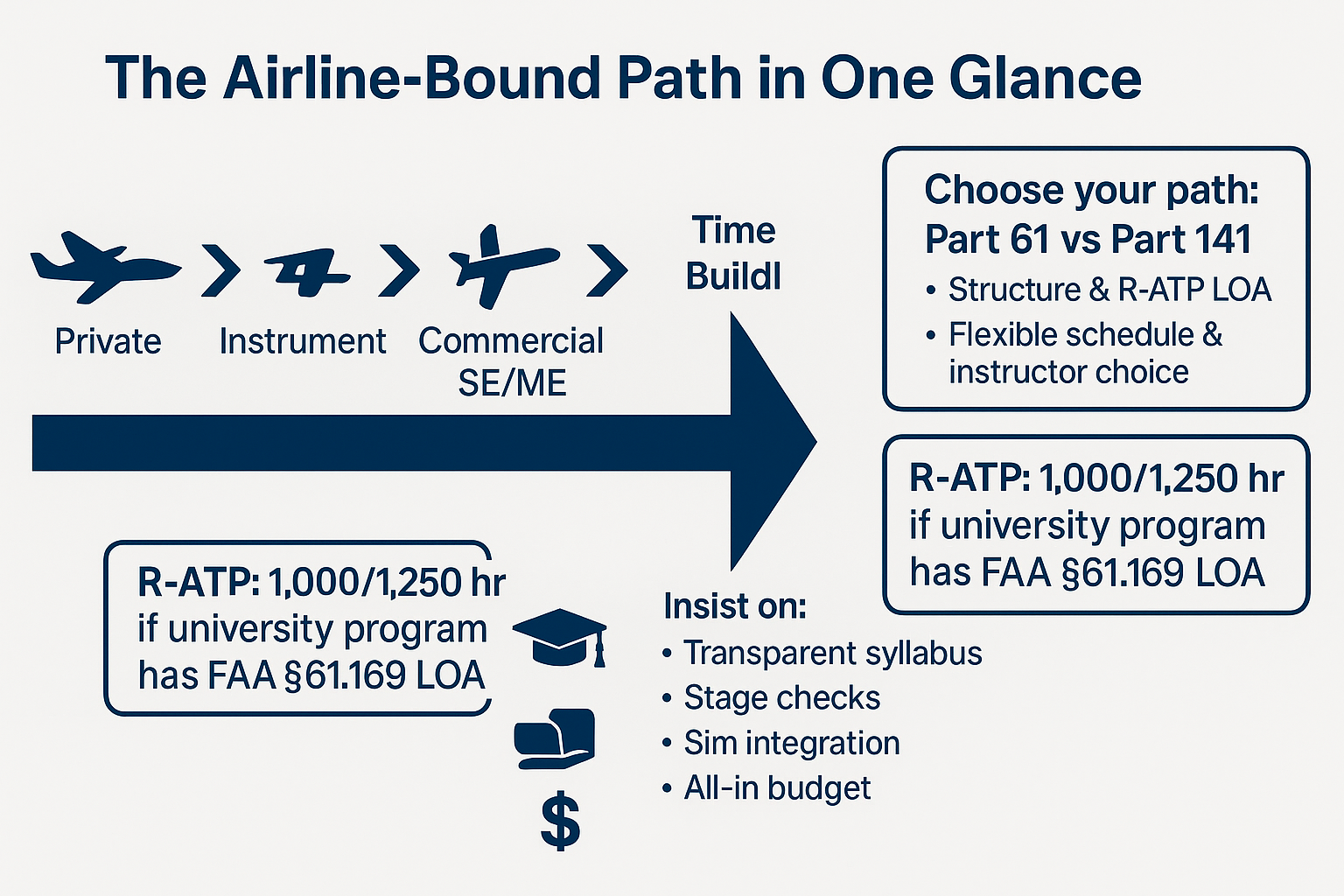
Sources
FAA & CFR references for hour minimums, syllabus/records, medical, and TSA:
- PPL minimums (40 vs. 35 hr): 14 CFR 61.109; Part 141 Appendix B. eCFR+1
- Instrument (50 hr XC PIC under 61; 35 hr 141 course): 14 CFR 61.65; Part 141 Appendix C. eCFR+1
- Commercial (250 vs. ~190 hr): 14 CFR 61.129; FAA memo explaining 190 hr under integrated 141; AOPA summary. eCFR+2FAA+2
- Stage checks & training records (Part 141): 14 CFR Part 141 (stage checks in appendices); §141.101 records; §141.37 check instructor. Legal Information Institute+2Legal Information Institute+2
- Medical & student pilot certificate: §61.23; FAA “Become a Pilot” page; FAA FAQ (medical before solo). eCFR+2FAA+2
- TSA AFSP: TSA FTSP announcement (Security Threat Assessment for non-citizens). TSA
- Sim credit: PPL §61.109(k); Instrument §61.65(h)–(j). eCFR+1
- Costs (examples): AOPA national range; example academy pricing (2025). AOPA+1
- R-ATP: 14 CFR 61.160 (1,000/1,250 hr collegiate paths). eCFR
